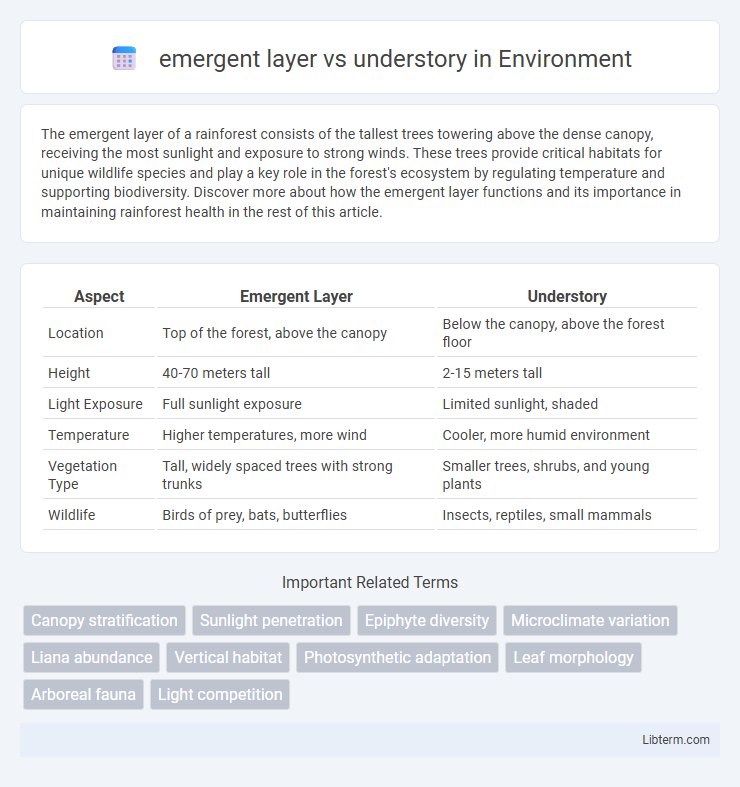The emergent layer of a rainforest consists of the tallest trees towering above the dense canopy, receiving the most sunlight and exposure to strong winds. These trees provide critical habitats for unique wildlife species and play a key role in the forest's ecosystem by regulating temperature and supporting biodiversity. Discover more about how the emergent layer functions and its importance in maintaining rainforest health in the rest of this article.
Table of Comparison
| Aspect | Emergent Layer | Understory |
|---|---|---|
| Location | Top of the forest, above the canopy | Below the canopy, above the forest floor |
| Height | 40-70 meters tall | 2-15 meters tall |
| Light Exposure | Full sunlight exposure | Limited sunlight, shaded |
| Temperature | Higher temperatures, more wind | Cooler, more humid environment |
| Vegetation Type | Tall, widely spaced trees with strong trunks | Smaller trees, shrubs, and young plants |
| Wildlife | Birds of prey, bats, butterflies | Insects, reptiles, small mammals |
Introduction to Forest Layers
The emergent layer in forests consists of the tallest trees that rise above the canopy, receiving the most sunlight and withstanding strong winds. Below it, the understory layer comprises smaller trees and shrubs adapted to low light conditions, providing crucial habitat for diverse wildlife. Both layers play essential roles in forest ecology by contributing to biodiversity, microclimate regulation, and nutrient cycling.
Defining the Emergent Layer
The emergent layer consists of the tallest trees in a forest, rising above the dense canopy and receiving the most sunlight. These trees can reach heights of over 70 meters, providing crucial habitats for birds and insects adapted to open, sunlit environments. In contrast, the understory is a shaded, lower layer beneath the canopy with smaller trees and shrubs adapted to limited light.
Characteristics of the Understory
The understory layer, located beneath the emergent and canopy layers of a forest, is characterized by limited sunlight, cooler temperatures, and higher humidity, promoting the growth of shade-tolerant shrubs and young trees. This layer features dense vegetation with smaller leaves adapted to capture minimal light, playing a crucial role in habitat diversity and nutrient cycling. The understory supports diverse wildlife, including insects, birds, and mammals, relying on its dense foliage for shelter and food sources.
Light Availability: Emergent vs Understory
Emergent layer trees receive maximum sunlight exposure, often capturing direct, unfiltered solar radiation due to their towering height above the forest canopy. In contrast, the understory experiences significantly reduced light availability, as dense foliage from upper layers filters sunlight, resulting in lower light intensity and a shaded environment. This difference in light availability drives distinct photosynthetic adaptations and species composition between the emergent layer and understory.
Plant Species Diversity in Both Layers
Emergent layer hosts tall pioneer species like Shorea robusta and Dipterocarpus alatus, supporting light-demanding plants and epiphytes adapted to high sunlight. Understory contains shade-tolerant species such as Calamus spp. and Alocasia macrorrhiza, exhibiting higher species richness in shrubs and herbaceous plants due to limited light penetration. Both layers contribute uniquely to tropical forest biodiversity by maintaining distinct plant communities with varying light and moisture adaptations.
Wildlife Adaptations in the Emergent Layer
Wildlife in the emergent layer of tropical rainforests exhibit unique adaptations such as strong, aerodynamic wings for navigating high altitudes and enhanced vision for spotting prey or predators from afar. Animals like harpy eagles and certain monkey species develop powerful gripping limbs to maneuver between towering trees exposed to intense sunlight and wind. These adaptations contrast with understory species, which rely on camouflage and slower movements to thrive in the dim, sheltered lower forest levels.
Animal Habitats in the Understory
The understory layer of tropical rainforests provides critical habitat for a diverse range of animals, including frogs, snakes, insects, and birds that rely on dense vegetation for shelter and hunting grounds. Unlike the emergent layer, which hosts species adapted to open, sunlit environments such as large birds of prey and certain mammals, the understory supports animals adapted to lower light levels and higher humidity. This layer's complex structure offers numerous microhabitats essential for breeding, feeding, and protection from predators.
Climate and Microclimate Differences
The emergent layer receives direct sunlight and experiences higher temperatures and wind exposure, creating a warmer and drier microclimate compared to the understory. The understory is shaded by upper canopy layers, resulting in cooler, more humid conditions with less temperature fluctuation. These microclimate differences influence species adaptation, moisture retention, and energy dynamics within tropical rainforests.
Ecological Roles of Each Layer
The emergent layer in tropical rainforests receives the most sunlight and hosts large, tall trees that provide critical habitats for birds and insects, facilitating seed dispersal and pollination. The understory, situated below the canopy, thrives in low light conditions and supports shade-tolerant plants, amphibians, and predators like snakes and jaguars, contributing significantly to nutrient cycling and microhabitat diversity. Both layers play essential ecological roles in sustaining forest biodiversity, energy flow, and ecosystem stability.
Human Impacts on Emergent and Understory Layers
Human activities such as deforestation and urban development disproportionately impact the emergent and understory layers by disrupting habitat structure and biodiversity. The emergent layer faces threats from selective logging and pollution, which reduce tree heights and canopy gaps vital for wildlife. The understory layer suffers from reduced light penetration due to canopy loss and invasive species, leading to diminished plant regeneration and altered microclimates.
emergent layer Infographic

 libterm.com
libterm.com